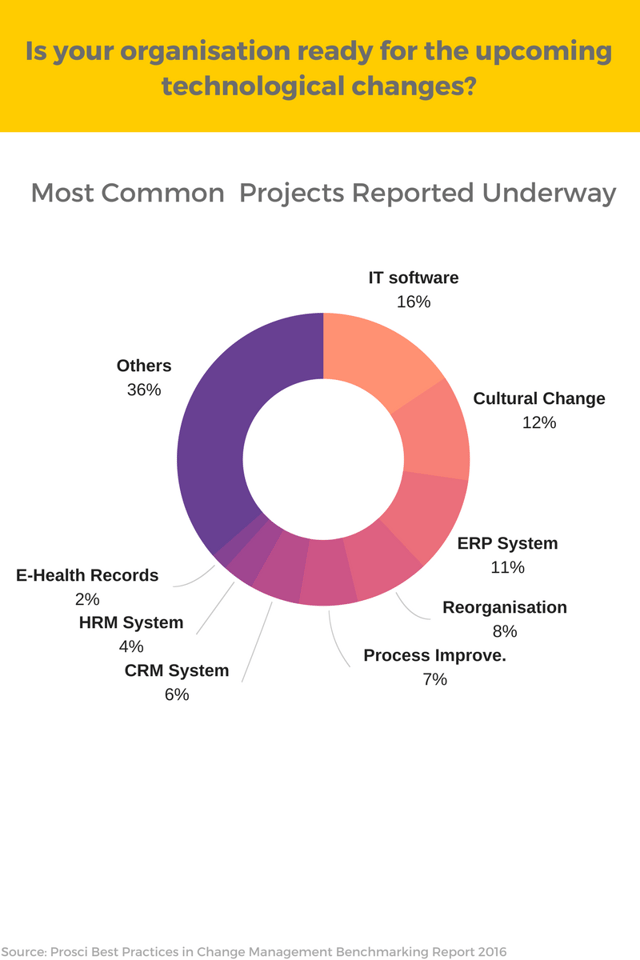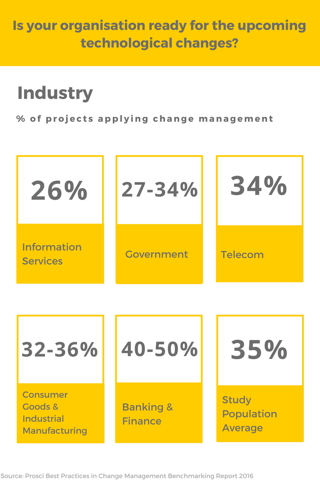Technological changes rapidly disrupt industries quickly redefining the rules of the game. Internal and external disruptions drive new business models Uber and GRAB in transport, Amazon and Alibaba in retail services, Airbnb and Booking.com in accommodation to name just a few. Innovative applications of digital possibilities are causing organisations, see Exhibit 1, to rethink and redesign processes that remove functional silos/bottlenecks and accelerate the flow of value from end to end. Organisations that don't change are disappearing more quickly and forever.
In this post we explore the relevance of effective change management to the leader of many of these disruptive initiatives, the CTO.

Exhibit 1 - Classification of projects reported in Prosci 2015 Change Management Benchmarking Research.
So why are many organisations not ready to adapt and exploit technological innovation as well as they might? According to McKinsey, see exhibit 2, the root cause is largely due to a lack of executive leadership and ownership and this is why they believe that every organisation should have a chief technology officer (CTO).

Exhibit 2 - Most companies and leaders believe that their organisations are not ready to cope with the changes required in the impending technological shifts.
However, simple assignment of responsibility is insufficient to prepare an organisation for major technological shifts. A CTO not only needs to be savvy about potentially "game changing" and relevant new technologies, like block-chain, digital twins, Artifical Intelligence etc but they also have to ensure deployment is fully executed by the whole organisation. Technologies do not work independently of people and it is important to build change capabilities within the organisational system that ensure people adopt and use technology in ways that maximise their financial and societal benefits.
In global organisations it is not uncommon to see expensive technology under-utilised because the people expected to use it don't know why they should, or how they can best, use it. A CTO who neglects to facilitate the integration of change management with project management and sponsorship will fail to deliver the return of investment (ROI) and intended benefits for many of their technological projects.
Lets look at the use of change management by industry, see exhibit 3. Clearly there is a great need for leaders to actively embrace their role in managing the people side of change if they want to see expensive technology solutions deliver maximum benefit. The CTO, as a part of the executive team owning the responsibility of delivering technological capabilities, should also, in significant part, own the responsibility of cascading change management across the organisation.
 |
 |
Exhibit 3 - Less than 50% of projects have change management applied to them across industry sectors and regions.
World Class Leaders Are Great Change Enablers.
People need to embrace, adopt and work together with technology to deliver its real value. The best leaders understand this and know that change management is an essential core competency of successful organisations. Great CTOs play an important role in enabling this internalisation of change management excellence.
Build a common change language and make the Prosci Methodology and tools work for you
In order for change management to be successful as part of a global company, its vital that each region sees change management resources as a positive tool meant for enabling projects and initiatives to realise their full benefits.
Organisations that experience most success in building enterprise level change management globally are those that take the time to implement change management training, develop and approach that meet the needs of each location, whilst also delivering the global strategy. Steps that show a commitment to making this work globally but also locally include, translating the materials into the native language of each geography and adapting the imagery to work within each unique culture.
If you are looking to implement change management on a global scale but are unsure where to start, attend one of our courses where one of our expert trainers can equip you with the skills you need to succeed.



